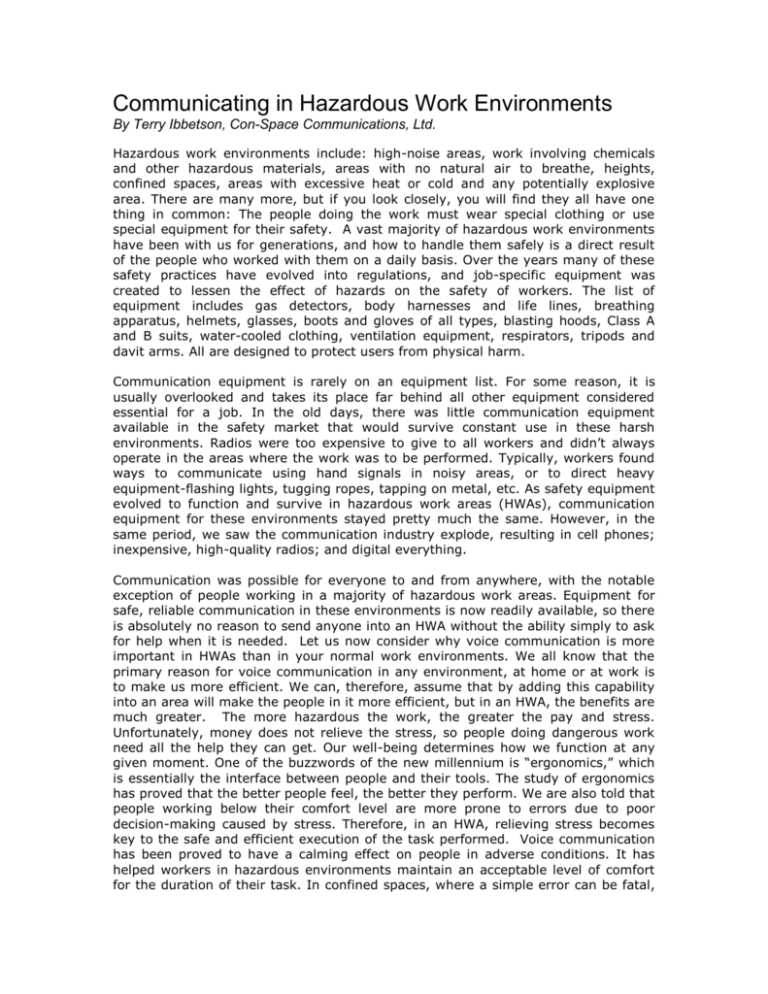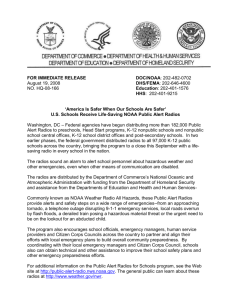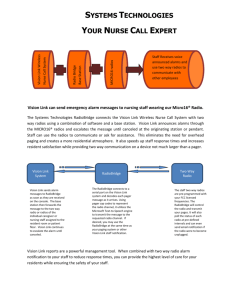Communicating in Hazardous Work Environments
advertisement

Communicating in Hazardous Work Environments By Terry Ibbetson, Con-Space Communications, Ltd. Hazardous work environments include: high-noise areas, work involving chemicals and other hazardous materials, areas with no natural air to breathe, heights, confined spaces, areas with excessive heat or cold and any potentially explosive area. There are many more, but if you look closely, you will find they all have one thing in common: The people doing the work must wear special clothing or use special equipment for their safety. A vast majority of hazardous work environments have been with us for generations, and how to handle them safely is a direct result of the people who worked with them on a daily basis. Over the years many of these safety practices have evolved into regulations, and job-specific equipment was created to lessen the effect of hazards on the safety of workers. The list of equipment includes gas detectors, body harnesses and life lines, breathing apparatus, helmets, glasses, boots and gloves of all types, blasting hoods, Class A and B suits, water-cooled clothing, ventilation equipment, respirators, tripods and davit arms. All are designed to protect users from physical harm. Communication equipment is rarely on an equipment list. For some reason, it is usually overlooked and takes its place far behind all other equipment considered essential for a job. In the old days, there was little communication equipment available in the safety market that would survive constant use in these harsh environments. Radios were too expensive to give to all workers and didn’t always operate in the areas where the work was to be performed. Typically, workers found ways to communicate using hand signals in noisy areas, or to direct heavy equipment-flashing lights, tugging ropes, tapping on metal, etc. As safety equipment evolved to function and survive in hazardous work areas (HWAs), communication equipment for these environments stayed pretty much the same. However, in the same period, we saw the communication industry explode, resulting in cell phones; inexpensive, high-quality radios; and digital everything. Communication was possible for everyone to and from anywhere, with the notable exception of people working in a majority of hazardous work areas. Equipment for safe, reliable communication in these environments is now readily available, so there is absolutely no reason to send anyone into an HWA without the ability simply to ask for help when it is needed. Let us now consider why voice communication is more important in HWAs than in your normal work environments. We all know that the primary reason for voice communication in any environment, at home or at work is to make us more efficient. We can, therefore, assume that by adding this capability into an area will make the people in it more efficient, but in an HWA, the benefits are much greater. The more hazardous the work, the greater the pay and stress. Unfortunately, money does not relieve the stress, so people doing dangerous work need all the help they can get. Our well-being determines how we function at any given moment. One of the buzzwords of the new millennium is “ergonomics,” which is essentially the interface between people and their tools. The study of ergonomics has proved that the better people feel, the better they perform. We are also told that people working below their comfort level are more prone to errors due to poor decision-making caused by stress. Therefore, in an HWA, relieving stress becomes key to the safe and efficient execution of the task performed. Voice communication has been proved to have a calming effect on people in adverse conditions. It has helped workers in hazardous environments maintain an acceptable level of comfort for the duration of their task. In confined spaces, where a simple error can be fatal, having constant voice contact during an entry can relieve the fears of entrants by keeping feelings of claustrophobia and panic in check. So let us look at the equipment available and decide what is best for the different categories of hazardous work activities. There are basically two types of portable voice communication equipment, the most common being portable radios, and the least-known being portable hardline communication systems. Each of these have their good and bad points, which dictate what they are best suited for, so we must be careful not to put round pegs into square holes, no matter how square the pegs look. This can be a challenge, but like everything else, understanding is essential. As mentioned earlier, the portable two-way radio is probably the most common piece of communication equipment used in all parts of all industries, so much so that cell phones are now available that can function as a phone or a radio. Operations requiring users to have freedom of movement, or those that are carried out in the open are best suited to radio equipment. The obvious benefit of radios is that they need no connecting cable and can accommodate an unlimited number of users. In addition, radios are available with many options and accessories, making communication possible with a wide variety of personal protective equipment (PPE) including respirators, breathing apparatus and fully encapsulated suits. Portable radios are typically lightweight, use rechargeable batteries, and certain models are Intrinsically Safe approved and can be used while working in explosive environments. Some of the negative aspects of radio equipment may not be readily apparent. For instance, radio equipment does not function reliably in enclosed spaces constructed of steel or concrete such as voids inside double hulls, tanks, sewers or towers. In these work environments, communication is subject to dead spots, fading, and weak signals, similar to what happens to car radios in tunnels. Also, in a word of caution, companies such as Boeing do not allow portable radios (even IS-approved ones) to be used near open aircraft fuel tanks for fear the transmit signal could ignite fuel fumes and cause an explosion when transmitting. Radio equipment is subject to unwanted monitoring and/or interruption by outside sources. Typically, radios are “push to talk,” which requires the use of one hand, and are without special accessories; they do not work well with facemasks of any type, respirators or breathing apparatus. As a final note, portable radios are subject to considerable abuse, and maintenance costs can be high. Portable hardline communication systems are not as common as two-way radios, but have grown in popularity, especially for confined space applications. At first glance, the biggest drawback to this method of communication is the cable itself. That said, the cable is also one of this item’s greatest assets, as hardwired systems typically excel in areas where radios fail. A prime example of this can be found in Chicago, New York, Pittsburgh and Philadelphia, where portable radios have been banned from high-rise crane operations on construction sites. All communication between crane operators and the ground must now be done using hardline communication equipment. On drilling rigs, connecting a new drilling rod takes coordination between two people about 90 feet apart, and requires both hands. Radios are not the answer for these applications, but a hardline system is. It gives its users instant, continuous, handsfree communication, (no buttons to push) and is not subject to dead spots or fading, all of the reasons why radios failed in these jobs. Confined spaces, on the other hand, are infinitely more complex and present problems that are impossible to solve without hardline equipment. These are typically areas where radios become unreliable due to the shielding effect of the surrounding metal and concrete. Workers in these environments need the use of both hands, and by regulation must be in constant contact with their safety attendant. A shielded cable facilitates communication without the worry of interference or dead spots. Portable hardline systems provide users with two-way hands-free communication on a dedicated, private network. When using supplied air-breathing apparatus, communication cable can be piggybacked onto the air-line, making a single umbilical that is easily managed by the entrant. Depending on the system selected, accessories for portable hardline systems include pass-through connectors for chemical suits, facemask communication accessories, high-noise headsets, alarm options and talk boxes. Units are battery-powered and able to deploy anywhere. Systems are available with high-level, Intrinsically Safe approvals for use in explosive environments. Negative aspects of a portable, hardwired communication system are the limited number of users per operation, physical attachment by cable, and distance limitations. People whose jobs place them in hazardous work environments have every right to maintain contact with people who can help them if a problem occurs. There are no excuses for them to be without this essential link to the outside, as voice communication equipment is now available that will operate and survive in their harsh surroundings. It seems that we have come full-circle and are trying to simplify tasks back into their basic components to make jobs easier for personnel. Add to this the increased need for safety in the workplace and the economic realities of doing more with less, and we have the dilemma that all company managers, supervisors and workers face on a daily basis. The correct application of communication technology in hazardous work areas can help increase the efficiency, productivity and safety of workers. Terry Ibbetson is President at Con-Space Communications,Ltd. tibbetson@con-space.com








